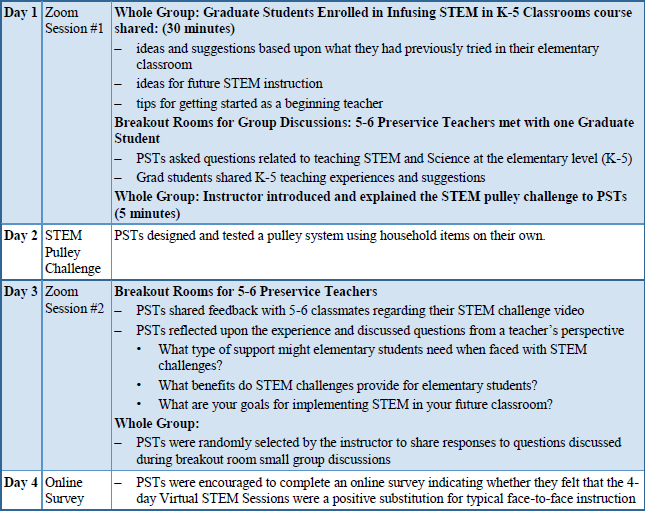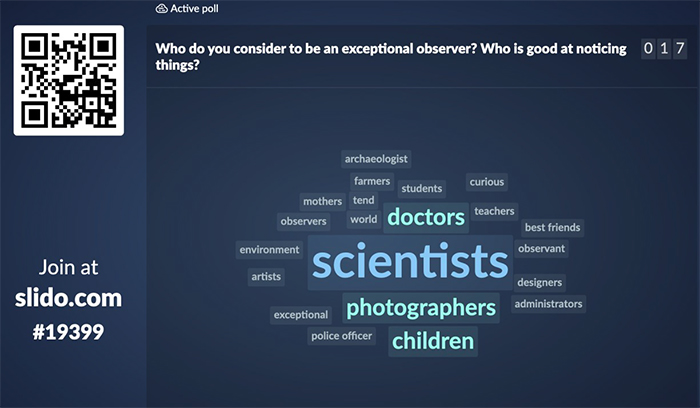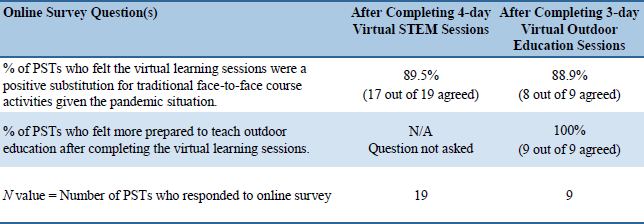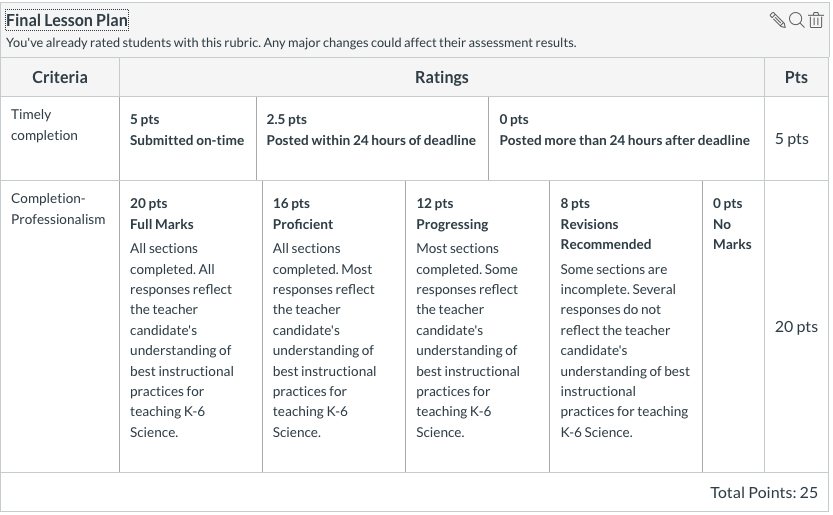Résumés
Abstract
The quick transition to remote learning during the COVID 19 pandemic helped prevent learning from being disrupted at higher educational institutions across the U.S. However, for many instructors and students, this rushed transition to forced online learning without preparation also caused confusion. This paper presents a best practice case study where a college instructor moved her traditional face-to-face, hands-on course to online blended learning (synchronous and asynchronous). Various forms of digital technology were creatively used to teach, model, and engage preservice student teachers in best instructional practices. Lessons learned and a variety of learning activities are shared, and opportunities and challenges are discussed.
Keywords:
- Pandemic,
- remote learning,
- forced online learning,
- emergency online learning,
- blended learning
Résumé
La transition rapide vers l’apprentissage à distance pendant la période de la COVID-19 a aidé les institutions d’enseignement supérieur des États-Unis à éviter d’interrompre les activités d’apprentissage. Toutefois, pour plusieurs enseignants et étudiants, cette transition rapide et sans préparation vers l’apprentissage en ligne a aussi créé une certaine confusion. Cet article présente une étude de cas de pratiques exemplaires dans laquelle un enseignant universitaire a transformé un enseignement traditionnel pratique et en face-à-face en un mode d’apprentissage hybride (synchrone et asynchrone). Divers outils technologiques ont été exploités afin d’enseigner, modéliser et impliquer des étudiants stagiaires dans les meilleures pratiques pédagogiques. Des leçons tirées de ces expériences et plusieurs activités d’apprentissage sont présentées. Les perspectives et les défis apparus sont aussi discutés.
Mots-clés :
- Pandémie,
- enseignement à distance,
- enseignement hybride,
- enseignement en ligne contraint,
- enseignement en ligne en urgence,
- enseignement hybride
Corps de l’article
Introduction
During the spring of 2020, college students in the U.S enrolled in face-to-face courses suddenly found themselves learning through an alternative delivery method called remote learning due to unprecedented campus closures caused by the COVID 19 pandemic. The quick transition to remote learning, primarily in the form of online learning, prevented learning from being disrupted during the pandemic. However, this rushed transition to online learning without preparation also caused chaos and confusion for many instructors and students depending upon their preparedness to teach and/or learn in an online setting. As argued by researchers and educators (Hodges et al., 2020), online learning carries a stigma of being lower quality than face-to-face learning, despite research showing otherwise. These headlong moves into remote learning, many of which are viewed as online learning by higher education institutions, could cement institutions’ perception of online learning as a weak alternative. Within the scope of this paper, we presented a best practice case study where a college instructor moved her traditional face-to-face, hands-on course to online blended learning (synchronous and asynchronous) and creatively used various forms of digital technology to teach, model, and engage Preservice Student Teachers (PSTs) in best instructional practices (i.e. inquiry-based learning, outdoor/environmental education, STEM instruction, and collaborative discussion) to prepare PSTs to effectively teach science in their future elementary classrooms. In the next section, we explain what these instructional practices are and why they were integrated into the course.
Inquiry-based learning refers to a “multi-faced activity that involves making observations; posing questions and examining books and other sources of information to see what is already known; planning investigations, reviewing what is already known in light of experimental evidence; using tools to gather, analyze, and interpret data; proposing answers, explanations, and predictions; and communicating the results” (National Research Council, 1996, p. 23); inquiry-based learning is advocated for by the Next Generation Science Standards (2013). Furthermore, the outdoor environment provides the ideal setting for inquiry-based learning. Guided by a properly trained teacher, outdoor/environmental education can result in greater student engagement and higher science achievement (Rios & Brewer, 2014) and has also been shown to positively impact student behavior and environmental attitudes (Szecykytko et al., 2018). Additionally, STEM experiences and instruction were provided to increase PSTs’ ability to prepare and implement STEM education. STEM education involves engineering design challenges using relevant technologies. It follows an interdisciplinary approach, so that the four disciplines (science, technology, engineering, and mathematics) are integrated within a meaningful or authentic context (National Academy of Engineering and National Research Council2009). A national report released in April 2016 (Office of the Press Secretary) highlighted the importance of promoting active STEM learning for children. On a related note, one of the six tenets essential to STEM instruction is providing opportunities for teamwork and communication (Moore et al., 2014). Collaborative discussions provide opportunities for PSTs and the instructor to work together and/or share ideas. Discussions can occur with all PSTs at once (whole group) or they can occur with smaller groups of 3-6 PSTs. During these collaborative opportunities, PSTs collectively function and contribute to a particular community of learners which aligns with Vygotsky’s (1978) social constructivist theory. Since learning is social, PSTs were provided frequent discourse opportunities to redefine and construct their knowledge and beliefs based upon their own classroom experiences and their classmates’ and teachers’ interpretations (Jin et al., 2016; Scott et al., 2007).
Process
Virtual STEM (Science, Technology, Engineering, and Mathematics) Instruction
Table 1
Timeline of Virtual STEM-based Sessions
For the first 4-day series of synchronous sessions via Zoom, a cloud-based peer-to-peer software platform used for teleconferencing, the instructor invited 5 graduate students enrolled in an online K-5 STEM course to share ideas and tips with twenty-seven PSTs. To do this, the instructor created Zoom Breakout Rooms and assigned 5-6 PST to one graduate student so that they could ask questions and interact with a practicing teacher/mentor. The instructor then gave an assignment in which PSTs could experience STEM through the lens of an elementary student. PSTs were given one day to independently create a pulley system using household materials. They used VidGrid, a screen recording and lecture-capture tool, to create a 3-5 minute video describing their materials, design and results, and to provide a scientific explanation of why their pulley worked or didn’t work. PSTs submitted their videos in Canvas, a learning management system used at the university, and were asked to view 5-6 of their classmates’ videos. The following day, the same 5-6 PSTs met in breakout groups and shared experiences. During an ensuing whole group discussion, PSTs reflected upon the experience from a teacher’s perspective. See questions in Table 1-Day 3. For homework, PSTs submitted online responses to the Table 1-Day 3 questions.
Virtual Outdoor/Environmental Education Opportunities
Table 2 outlines the second 3-day series of synchronous sessions (Days 5-7) during which the instructor facilitated online outdoor education activities to model and engage PST in inquiry-based learning. On Day 5, each PST brought a rock and the instructor asked questions related to being a ‘good observer.’ PSTs responded using SliDo, an interactive gamification system (See Figure 1).
Table 2
3-Day Timeline of Virtual Outdoor/Environmental Education Sessions
Figure 1
PSTs’ responses to the question, “Who do you consider to be an exceptional observer?”
The use of two different data sources is also for triangulation purposes, since using multiple methods or data sources in qualitative research develops a comprehensive understanding of the phenomena (Patton, 1999). It is also a qualitative research strategy used to test validity and reliability through the convergence of information from different sources (Carter et al., 2014).
Preliminary Findings
Data Source #1: Two Online Surveys
At the conclusion of the 4-day virtual STEM sessions and again at the conclusion of the 3-day virtual outdoor/environmental education sessions, PSTs were encouraged to respond to an online survey asking whether they felt that the use of virtual sessions were a positive substitution for typical face-to-face instruction. The preliminary results of the 4-day virtual STEM sessions survey indicated that 89.5% of the PSTs who responded felt the use of STEM synchronous sessions/activities were a positive substitution for traditional face-to-face course activities given the pandemic situation. See Table 3. As shown in Table 3, 88.9% of the PSTs who responded to the second survey (n = 9), felt the 3-day virtual outdoor/environmental education sessions and activities were a positive substitution for traditional face-to-face course activities given the pandemic situation. In response to a second question that was asked in this survey, 100% of the nine PSTs who completed the survey felt more prepared to teach K-5 outdoor/environmental education after the 3-day virtual sessions.
While not all PSTs responded to the optional survey, the responses indicate similar satisfaction with typical face-to-face instruction. The response rate was definitely a limitation of this study since it yielded an inconsistent and much smaller n value for the 4-day STEM survey (n = 19) vs. the 3-day outdoor education survey (n = 9). This drop in participation may have been due to the PSTs’ virtual learning fatigue by this time, and/or end of the semester burnout. In order to learn more about the effectiveness of virtual learning compared to traditional learning, it would be beneficial to require that the survey be submitted by all PSTs in the future.
Table 3
Results of online surveys regarding PSTs’ perceptions of virtual learning after completing 4-day virtual learning sessions
Data Source #2: Online assignment- Develop an Outdoor Education Lesson Plan
At the completion of the 3-day virtual outdoor/environmental education sessions, each PST was required to use what was learned to develop a lesson plan that could be used in the future to teach outdoor education to students between the ages of 6 and11. The instructor evaluated the PSTs’ outdoor education lesson plans using the same scoring criteria/rubric that was used to score outdoor education lesson plans developed by PSTs who completed their 3-day outdoor/environmental education sessions face-to-face during the previous semester. See Figure 4. From the instructor's perspective, PSTs’ online outdoor education lesson plans were of similar or greater quality than those submitted by PSTs who completed face-to-face outdoor education sessions during the previous semester based upon their overall rubric scores. Both semesters, the PSTs’ outdoor education lessons incorporated effective instructional practices learned from the outdoor education sessions (i.e. inquiry-based learning, collaborative discussion, and safety procedures).
Next, pairs of PSTs were assigned to Breakout Rooms and took turns making multimodal observations about their rocks, including properties such as color, size, weight, and texture.
On Day 6, the instructor shared images of various species including: a deer, a snake, and a bee. After seeing each image, PSTs used the Zoom chat feature to type the first word they thought of. The instructor then facilitated a discussion about how teachers’ perceptions can impact elementary students if biases/fears are inadvertently shared. Next, PSTs met in breakout rooms and conducted Internet research to determine benefits associated with one of the species. The groups reconvened and each group shared what they learned and explained whether or not their initial perceptions had changed. For homework, PSTs were encouraged to complete another online Survey indicating whether they felt that the 3-day Virtual Outdoor Education Sessions were a positive substitution for typical face-to-face instruction.
Data Collection and Analysis
This exploratory qualitative study attempts to examine the effectiveness of using a variety of digital technology tools to create an interactive and experiential online learning environment for PSTs in a traditionally hands-on methods course. Data was collected from two sources: (1) An optional online survey was administered after the 4-day STEM and 3-day Outdoor/Environmental Education virtual learning sessions in an effort to gain a sense of PSTs’ satisfaction/perception of the virtual sessions compared to traditional instruction. Descriptive analysis was used to analyze the online survey results. (2) PSTs individually prepared an outdoor education lesson. The lesson was evaluated by the instructor to determine whether the PSTs were able to apply what they learned during the 3 virtual outdoor education sessions to future teaching opportunities. These scores were compared to the instructor’s evaluation of the outdoor education lessons that PSTs prepared during the previous semester after they received 3 days of traditional face-to-face outdoor education. Outdoor Education lessons were evaluated using the same rubric (See Figure 2).
Figure 2
Rubric used to score PSTs’ final lesson plans for traditional face-to-face instruction last semester and for online instruction during the Covid-19 pandemic
The mean score of PSTs’ outdoor education lessons after completing the 4-day virtual learning sessions was 97% (n = 27). This percentage exceeded the mean score of 88% (n = 36) from the previous semester, when outdoor education sessions were conducted in a traditional face-to-face setting. The preliminary results indicate that learning performance was better with the online course format.
Discussion and Conclusions
Challenges
The swift transition to remote learning, mostly in the form of emergency/forced online learning, prevented learning from being disrupted, but it did not take into account how to emulate teaching style/personality and/or collaborative and interactive pedagogy that occurred in the face-to-face classroom. When teaching the course face-to-face, the instructor used research-based instructional practices for teaching science, such as a student-centered, inquiry-based learning approach that incorporated hands-on investigations, physical movement, and collaborative discussion on a daily basis. This type of active learning was difficult to replicate during the switch to remote learning for several reasons. Without having sufficient time to transition to remote learning, the instructor was unable to supply and send home materials that would have enabled the students to conduct hands-on, interactive learning remotely. As a result, the STEM and outdoor education lessons traditionally used in the face-to-face course were adapted for remote learning based upon PSTs’ ability to access common household materials. In addition, technological options and solutions such as using synchronous sessions via Zoom were used to create breakout rooms for small group discussions so that PSTs could share and discuss their experiences with one another. However, some instructional time was lost during the process of assigning students to breakout rooms. Also, a few PSTs’ inadvertently exited the meeting rather than leaving their Zoom breakout room, which required them to rejoin the meeting and wait for the instructor (host) to allow them back into the Zoom session. Similarly, students with dated technology and/or limited Internet access took longer than others to rejoin the main room after leaving breakout rooms, since attending synchronous sessions require more bandwidth. Another challenge emerged once PSTs learned how to use the chat feature in Zoom in order to share responses during the virtual lessons. The instructor noticed that two students were using the chat feature to engage in private off-topic conversations with peers. It became apparent that clear expectations and netiquette are necessary in order to successfully facilitate synchronous learning sessions. All of those challenges echoed what Fosslien and Duffy (2020) discussed as part of how to combat "Zoom fatigue". Finally, students with accessibility issues may find it more challenging in this emergency/forced online learning environment, where accessibility support is limited.
These challenges could be overcome in well-planned online course design when stakeholders including instructional designers, instructors and students have sufficient time to work on it (Lee & Choi, 2011). Given the emergency situation of the pandemic, the move from traditional courses to forced online learning allowed instructors and students to experience new learning approaches and opportunities that in normal circumstances, they may not experience.
Opportunities for future research and instruction
Our preliminary findings indicated that emergency remote teaching and the use of any alternative delivery methods to ensure instructional continuity, if creatively and appropriately implemented, can make learning happen. The primary advantages are the flexibility and convenience of teaching and learning anywhere and anytime especially during the pandemic period to help prevent the spread of the virus COVID 19. The findings also highlighted the fact that the interactive and hands-on learning experience to which PSTs were exposed in this case study addressed many well-documented challenges in online learning such as (a) difficulties with hands-on learning activities (Mawn et al., 2011); (b) limited learning resources/materials available to conduct hands-on learning (Orton-Johnson, 2009); (c) students' disengagement (Young & Bruce, 2011); (d) instructors' limited presence (Richardson et al., 2015); and (e) timely support (Vu et al., 2016).
Parties annexes
References
- Carter, N., Bryant-Lukosius, D., DiCenso, A., Blythe, J., & Neville, A., J. (2014). The use of triangulation in qualitative research. Oncology Nursing Forum, 41(5), 545–547 https://doi.org/10.1188/14.ONF.545-547
- Fosslien, L., & Duffy, M. W. (2020, April 29). How to combat Zoom fatigue. Harvard Business Review. http://hbr.org/...
- Hodges, C., Moore, S., Lockee, B., Trust, T., & Bond, A. (2020, March 27). The difference between emergency remote teaching and online learning. Educause Review. http://er.educause.edu/...
- Jin, H., Wei, X., Duan, P., Guo, Y., & Wang, W. (2016) Promoting cognitive and social aspects of inquiry through classroom discourse. International Journal of Science Education, 38(2), 319‑343. https://doi.org/10.1080/09500693.2016.1154998
- Lee, Y., & Choi, J. (2011). A review of online course dropout research: Implications for practice and future research. Educational Technology Research and Development, 59(5), 593‑618. https://doi.org/10.1007/s11423-010-9177-y
- Mawn, M. V., Carrico, P., Charuk, K., Stote, K. S., & Lawrence, B. (2011). Hands‐on and online: scientific explorations through distance learning. Open Learning: The Journal of Open, Distance and e-Learning, 26(2), 135‑146. https://doi.org/10.1080/02680513.2011.567464
- Moore, T. J., Stohlmann, M. S., Wang, H. H., Tank, K. M., Glancy, A. W., & Roehrig, G. H. (2014). Implementation and integration of engineering in K-12 STEM education. In S. Purzer, J. Strobel, & M. E. Cardella (Eds.), Engineering in pre-college settings: Synthesizing research, policy, and practices (pp. 35‑60). Purdue University Press.
- National Academy of Engineering & National Research Council. (2009). Engineering in K-12 education: Understanding the status and improving the prospects. The National Academies Press. https://doi.org/10.17226/12635
- National Research Council. (1996). National science education standards. National Academy Press. http://csun.edu/...
- Next Generation Science Standards. (2013). http://nextgenscience.org
- Office of the Press Secretary (2016). FACT SHEET: At White House Science Fair, President Obama calls on this generation of students to tackle the grand challenges of our time. The White House. http://obamawhitehouse.archives.gov/...
- Patton, M. Q. (1999). Enhancing the quality and credibility of qualitative analysis. Health Services Research, 34(5 Pt 2), 1189–1208. http://ncbi.nlm.nih.gov/...
- Orton‐Johnson, K. (2009). ‘I’ve stuck to the path I’m afraid’: Exploring student non‐use of blended learning. British Journal of Educational Technology, 40(5), 837‑847. https://doi.org/10.1111/j.1467-8535.2008.00860.x
- Richardson, J. C., Koehler, A. A., Besser, E. D., Caskurlu, S., Lim, J., & Mueller, C. M. (2015). Conceptualizing and investigating instructor presence in online learning environments. The International Review of Research in Open and Distributed Learning, 16(3). https://doi.org/10.19173/irrodl.v16i3.2123
- Rios, J. M., & Brewer, J.. (2014). Outdoor education and science achievement. Applied Environmental Education & Communication, 13(4), 234–240. https://doi.org/10.1080/1533015X.2015.975084
- Scott, P., Asoko, H., & Leach, J. (2007). Students conceptions and conceptual learning in science. In S. Abell & N. Lederman (Eds), Handbook of research on science education, (pp. 31‑56). Routledge.
- Vu, P., Fredrickson, S., & Meyer, R. (2016). Help at 3:00 AM! Providing 24/7 timely support to online students via a virtual assistant. Online Journal of Distance Learning Administration, 19(1). http://westga.edu/~distance/ojdla/...
- Vygotsky, L. S. (1978). Mind in society: The development of higher psychological processes. Harvard University Press.
- Young, S., & Bruce, M. A. (2011). Classroom community and student engagement in online courses. Journal of Online Learning and Teaching, 7(2), 219‑230. http://jolt.merlot.org/...
Liste des figures
Figure 1
PSTs’ responses to the question, “Who do you consider to be an exceptional observer?”
Figure 2
Rubric used to score PSTs’ final lesson plans for traditional face-to-face instruction last semester and for online instruction during the Covid-19 pandemic
Liste des tableaux
Table 1
Timeline of Virtual STEM-based Sessions
Table 2
3-Day Timeline of Virtual Outdoor/Environmental Education Sessions
Table 3
Results of online surveys regarding PSTs’ perceptions of virtual learning after completing 4-day virtual learning sessions







